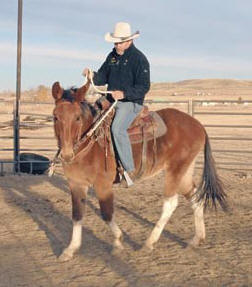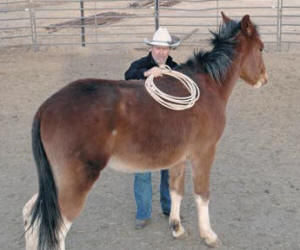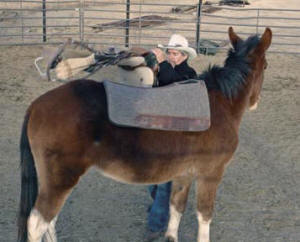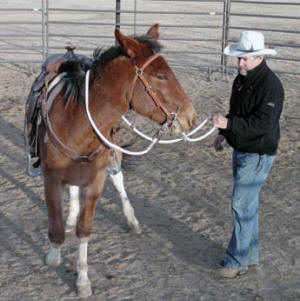|
Starting a Mule Under Saddle
By Tim Doud
Diamond Creek Mules, Cody, Wyoming
Reprinted with permission from
Mules and
More Magazine, April 2010 |
 |
| TIM
keeps this mule turning and responding to his cues
as he rides him for the first time. |
This is the time of year when people start their young colts,
either by sending them to a trainer or starting their mule
themselves. Many people refer to starting a colt as “breaking a
colt.” “Breaking” is a violent term that means using force.
Starting a mule is building a partnership between the trainer
and the mule. If the mule is asked to respond to a cue, instead
of forced to respond, you will get better performance from the
mule which results in a mule that wants to learn. If the mule is
forced into a cue he will be stiff and resistant. He will also
build resistance to all people. The mule will respond to a
rider’s cue, but will also pin his ears or swish his tail or
even try to buck you off.
Starting a colt under saddle is a very time consuming task. You
have heard the old saying, “You get what you pay for.” This is
never more true as it relates to training. There is always a
trainer down the road that will train your mule for half of the
price in half the time. However, most of these 30-day trainers
will get on the mule and “buck him out” (riding the mule until
he stops bucking and accepts the rider, if the rider can stay on
that long) or use force to train your mule.
Similarly, some owners want their mule to be started in a month
or two. Then, when the owner starts riding the mule at home,
they find the holes. The mule runs off, bucks them off, is hard
to catch, etc.
Everyone wants a bomb-proof mule in a month. It takes years and
years of training to train a mule to this level. I am not saying
you must have your mule in training with a trainer for many
years. The mule owner can do most or all of the training. But,
you do have to stay consistent and continue working towards your
goal. Training is not rocket science.
I receive many complements each year about my main two riding
mules, “Diamond Creek Angel” and “Diamond Creek Grover.” The
complements are usually the same. “They are so well trained, I
would love to have a mule like that.” But, what many forget is
that I have been training Angel and Grover for years, not
months.
The big craze now is colt starting clinics and competitions. You
can start a colt in three days or three hours, but after that
three days or three hours, that colt can only be ridden by a few
very experienced riders. You can not attend a three or four day
clinic and then start trail riding your mule the next day. An
experienced trainer will instruct their participants that even
though they are riding the mules, they must review the lessons
they have learned in the clinic several hundred times so he
fully understands what he has learned.
I will not take a mule to start unless the owner will commit the
mule to a minimum of three months of training. You must build a
foundation with the mule before you ride him. The foundation
will be built through ground work. This will build the
partnership between the mule and rider that teaches the mule to
look to the rider for cues instead of reacting on his own.
Instead of running off or bucking when afraid, the mule will
wait for the rider to give him a cue.
Bridle work is very important and should be done before the mule
is mounted for the first time. All mules I start are taught to
respond lightly to rein pressure; giving to the bit, disengaging
his hind quarters, moving his shoulders, turning and stopping
from the ground. This will keep the rider safe when riding
because the mule already knows my rein cues during the very
first ride.
 |
| Sacking-out a mule
teaches him to face his fear and not move his feet when
he is afraid. |
| |
 |
| The mule should
stand still when saddled. |
| |
 |
| The mule should
respond to light rein cues on the ground before you get
on his back. |
Next, the mule needs to be “sacked-out.” Sacking-out a mule
teaches the mule to stand still while objects are tossed around
him or rubbed on him. You are not desensitizing the mule. It is
impossible to present everything he will see in his life to him.
You are teaching the mule to not move his feet when he is
afraid.
Some people like to tie the mule’s hind leg up and force the
mule to stand while being sacked out, saddled and mounted. I
would like my mule to “want to” stand still beside me. Forcing
anything is bad news. It will show up later as a problem and
could hurt you or your mule.
You want to teach your mule to be okay with all kinds of objects
including the saddle pad and saddle. After the mule will stand
still with nothing on his head, I will start sacking out the
mule with a rope. This will get the mule used to objects around
his legs and teach him to not run away. If he is afraid of
things behind him I will ground drive the mule.
The mule will also need to be taught to stand still when mounted
and not move off until the rider cues the mule to move. This is
accomplished with all the sacking-out and rope work.
When you are ready to ride the mule for the first time, you
should ask yourself “Is there anything else I should teach or
continue to practice with the mule?” The answer is always “yes.”
There is always more you can do to prepare the mule to be
ridden, but you will know when it is time to start riding.
Be sure your mule stands to be saddled, leads well, picks up all
four feet without resistance, bridles well, is calm when you are
working with bags and tarps around him, is easy to catch, stands
tied and responds to the bridle well. These are all things your
mule should do well before you consider mounting for the first
time.
It is very important to give the mule a positive experience when
you ride your young mule. Do not think you must ride the mule
for “x” number of minutes. You can build the number of minutes
you ride later.
When you do start to ride, keep your riding time short; five to
10 minutes at a time. I may ride a young mule for an hour on the
first ride, but I will dismount six times. Instead of one hour
long ride, I ride six 10-minute rides. This gives the young mule
needed breaks.
When I get on a mule’s back, the first thing a mule is thinking
is “Oh, no. I have to carry this guy around for the rest of my
life!” The rider knows what is happening, but the mule does not.
By keeping the first rides short, we have told the mule that
this is not permanent.
It is also very important to keep a young mule busy when you
ride. Ask the mule to disengage it’s hind quarters to the right,
then left, then move his shoulder to the left, then right. By
constantly turning the mule and having the mule respond to a
cue, the mule will be less likely to be distracted or spook. It
is hard for the mule to think about a scary object if he is
thinking about a cue. It is also hard for a mule to run off if
he is focused on something else and his body is bent as he is
disengaging his hip.
Let the mule know you are on his back by praising and rubbing on
the mule as you ride. Make sure your body stays in the proper
riding position as you do.
Sometimes, I take mules in training that need to be restarted.
These are mules that have so many holes in their training that
it is easier to restart them. Any mule can be started under
saddle, but you will find it is easier to start a young mule
than restart an older mule. Once a mule develops a problem like
running off or bucking, it can be fixed, but if often takes more
time and consistency and can be hard to fix.
Purchasing or raising a young mule and starting the mule under
saddle is a long term commitment and not for everyone. But if
that is the avenue you wish to take, it can be a very rewarding
experience.
|
|
Tim can be reached at
www.diamondcreekmules.com, or by phone at 307/899-1089, or
email:
bliss@wavecom.net.
|
|
|
|
|
|
Mules and More |
April 2010 |
|
|